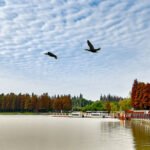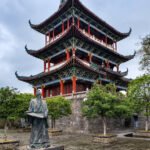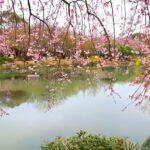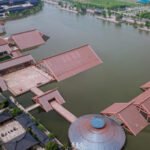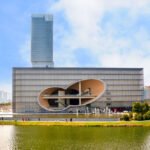Duration: 1 day. Time: November. Per capita cost: 150 yuan. Companions: Spouse. Activities: Photography, independent travel, hiking. The author visited these places: Qingxi Country Park, Shanghai廊桥. Posted on December 11, 2020, 15:26. Qingxi Country Park is positioned as a suburban wetland country park. It is the only suburban park in Shanghai featuring wetlands. Especially, its diverse aquatic species can be regarded as Shanghai’s natural local aquatic species gene bank and has the reputation of ‘Kanas on the water’. The park highlights the construction characteristics of ‘taking forest as the body, wildness as the soul, and water as the charm’. It shows ‘Qingxi in dreams, wetland with rippling water’. The entire scenic area is built around the Dalian Lake wetland in Qingpu District. The scenery is charming and natural. It satisfies the dream of urbanites to return to rural areas and pursue memories of Jiangnan. In Qingpu, the ‘land of fish and rice’ in Shanghai, there is hidden the only suburban park in Shanghai featuring wetlands. With the water fir forest planted 38 years ago as the ‘treasure of the park’, relying on the Dalian Lake ecological restoration project, there are rippling blue waves and the sight of fir forests and herons in Qingxi Country Park. ‘Lakes, beaches, shoals, and islands’ are crisscrossed. The water surface area in the park accounts for one-third. There are diverse aquatic species. With the themes of wetland, ecology, nature, and relaxation, it has three functional areas: water town farmland demonstration area, ecological conservation function area, and fishing village leisure experience area. The main landscapes include water forest, fir forest and heron sight, Qingyun wild path, reed flower area, wetland with rippling water, Peach Blossom Ferry, etc. Among them, the more than 60 mu of water forest is unique in Shanghai and is known as a fir forest wonder. Qingxi is homophonic to ‘Qingxi Stream’. The water forest, the treasure of the park, is full of water charm and aura. I think the following ancient poem is particularly suitable for describing the ethereal and quiet beauty of Qingxi. The fir tree is a unique tree species in China and a national first-class protected plant. It has the reputation of ‘the giant panda in the plant kingdom’. In late autumn, the beautiful tree posture is reflected in the water, astonishing all tourists. Every late autumn and early winter, the originally emerald green leaves of the metasequoia turn ochre red and stand in the water, very spectacular. In Qingxi Country Park in Qingpu District, Shanghai, there is a ‘water forest’. It is also the only ‘water forest’ in Shanghai. Centered around Dalian Lake, it covers an area of 83 mu. Under the illumination of morning light, a large area of metasequoia stands in the water. The water surface is like a mirror, reflecting the straight trunks of the trees. The trees that have grown for 38 years have adapted to growing in the water. The thick roots are firmly rooted in the water. The dark red metasequoia stands toweringly. Under the sunlight, it is extremely beautiful. Occasionally, water birds pass by and stop, becoming a picture worth treasuring. Every year during the winter season (from November 20 to December 20) is the best viewing period. Let’s go to Qingxi Country Park to appreciate the metasequoia forest in the most beautiful season of Magic City! The autumn of Qingxi Country Park is not only golden yellow, but also colorful and gorgeous… Here there are lakes, rivers, and various birds such as Moorhen, Little Grebe, Magpie, Night Heron, Dalian Lake Egret, Shrike, Rufous-tailed Bush Robin (male), Rufous-tailed Bush Robin (female) in Lianhu Village. The scenic area is very large. The parking lot and bus stop are far from the scenic area entrance. You can choose to take the scenic area tour battery car. During the best viewing period, you need to wait in line.
Accessing the scenic area requires a long hike. On our first visit, we opted to walk along the way to enjoy the sights, choosing not to take the scenic electric cart. This proved to be the right decision as there were numerous scenic spots along the way that were perfect for photography. We got off the bus at Zilian Road and had to walk north for over 900 meters to reach the visitor center. This was a straight and smooth asphalt road, the black surface traversing through the surrounding farmlands, looking particularly beautiful and dazzling. Along the road were hundreds of meters of thick, square log wisteria trellises. Although it is autumn now and the wisteria flowers have long wilted, the intertwining wisteria on the trellises remain lush and verdant, with emerald vines filling the long corridor, layer upon layer, stretching out of sight. Next spring, when the wisteria blooms, clusters of wisteria flowers hanging from the trellises will form a purple ‘time tunnel,’ a truly spectacular sight. Alongside the main road is a river filled with withered lotus leaves. One can imagine how beautiful the green lotus would be rippling on the water in summer. We made a promise to come back in summer to admire the lotus. On the river surface, white egrets and gray herons are occasionally seen hunting and soaring, respectively. Although the large lotus lake in autumn is slightly less impressive than in spring and summer, it has its own autumn charm. The small grebes leisurely swim in the river. Upon entering the country park, one is greeted by a scene of a new rural Jiangnan water town in Shanghai. Our mood also becomes relaxed, and the fatigue from the journey dissipates. White walls and black tiles, farmhouses scattered orderly, create a peaceful, serene, and harmonious atmosphere. The park is vast, and it still retains the natural village of the original inhabitants—Lianhu Village. With crisscrossing rivers and lakes, pastoral scenery, scattered farmhouses, and a rustic yet elegant rural style… On the 3200 acres of arable land, high-quality rice, green fruits and vegetables, and lotus root crops allow the rich green to flow freely. In 2014, Lianhu Village was included in the first batch of beautiful village construction at the Qingpu District level. In 2015, it was rated as a beautiful village demonstration village in Shanghai, in 2018 it was awarded the National Ecological Culture Village, and in 2018 it was also selected as one of the first batch of Shanghai rural revitalization demonstration village pilot villages. ‘Lotus threads wind around the wrist, water chestnuts pull at the clothes from afar.’ Here, there are thousands of acres of lotus ponds with lotus leaves spread out, and fish playing among the lotus leaves. ‘A river of misty water reflects the clear sky, with houses on both banks connected to the eaves like a painting.’ Here, there are white walls and black tiles, green waters flowing, a poetic paradise. This is the rural market. The rural market, walking about 700 meters west on Lianxie Road, offers a panoramic view of the water and sky of the large lotus lake. The entire Qingxi Country Park is laid out around the large lotus lake. It is an almost isosceles triangular lake surface. The large lotus lake is famous for its rippling lake surface and large areas of lotus flowers. Wetland lotus ponds wander around the large lotus lake, with a 5.5-kilometer lake loop trail that is quiet and has an excellent view.

Dalian Lake is a natural lake covering an area of 1 square kilometer, with wild lotuses growing in the wetland around the lake, making it a scenic spot for wetland lotus ponds. Unfortunately, early autumn is not the season for appreciating lotus flowers. From a distance, the lotus flowers have already withered, and the lotus leaves have turned yellow and dry. Next year, during the months of June and July, this place will surely be a moonlit lotus pond, beautiful and stunning, which is said to be the most beautiful season to visit Qingxi Country Park. In summer, the pond is filled with lush green and bright red, but come autumn, after a night of wind and rain, only the ‘remaining broken lotus leaves listen to the sound of rain’. Under the bright moon, as the autumn wind blows, the lotus pond leaves float, and flowers and branches wither away. The dew on the withered lotus leaves reminds one of the beautiful season they had in summer, yet I distinctly see the lonely and confident beauty hidden in the slow pond of broken lotus leaves! Once luxurious and bustling, they have now faded into a mass of broken branches and leaves. Looking far into the heart of Dalian Lake, there are three small islands of 500 square meters each, collectively known as Lianxin Island, with lush vegetation on the islands. There seem to be no buildings or original inhabitants on the islands. On the west side of Dalian Lake, separated by a road from Dalian Lake, lies an endless expanse of rice fields, like a huge golden carpet spread between heaven and earth. White farmhouses dot the rice fields in the distance, like a rich oil painting, too beautiful to behold. Here, high-quality frog rice is planted, a single late-season rice variety chosen from the high-quality thin rice varieties of Qingpu, located within the drinking water source protection area of the upper reaches of the Huangpu River. The ‘frog-rice coexistence’ cultivation method is used to protect and nurture the rice with frogs, effectively controlling pests in the rice fields while ensuring food safety, reducing environmental pollution, and promoting sustainable agricultural development. Heading from the south to the northeast, you will pass by the Dalian Lake Service Station after passing through the Golden Port. After walking past the service station, about a hundred meters ahead is the Reed Snow Maze, which can only be viewed from a distance. Further along, you will arrive at the Lianxin Bridge. The Lianxin Bridge consists of two arched bridges, a wooden pavilion, and a winding plank road, where you can see a large area of thriving reeds in the wetland beside the bridge swaying with the wind. Standing on the plank road, on the first arched bridge, you can capture the winding plank road, the lake pavilion, the Reed Snow Maze, the distant Yongjing Temple, and the blue sky and white clouds in the camera, which is quite a feeling. The guide map indicates that opposite the Lianxin Bridge and the Reed Snow Maze is the watery wetland, which is separated within the main scenic area of the park, the ‘Ecological Conservation Area’. Through the wire mesh, you can see a lotus pond where a worker is harvesting lotus roots. In the morning, you see lotus roots being pulled from the pond, and in the afternoon, you see the lotus roots being sorted and bagged on the river surface, with a long lotus root carrying the joy of harvest heading home. Walking along the lake trail, you will arrive at the Ecological Conservation Area. Due to the epidemic, only one entrance is open, where you can enter the park by showing your health code and having your temperature checked.
On the right side of the ecological conservation area of Cedar Forest and Heron Shadow is the Water Ripple Wetland, and on the left side is the Cedar Forest and Heron Shadow. It is a cedar forest by the pond. The water surface is clear. From time to time, a egret circles in the air. The Cedar Forest and Heron Shadow is a cedar forest by the pond on land. Some of the pond cedars here have already put on red makeup, some are still verdant, and some are dyed yellow. The branches are heavily hung with round fruits. There are also sporadic pond cedars in the water in the lake here. There are lakes, rivers and birds here. The birds are egrets and night herons. The blue sky, warm sunshine, tranquil lake water, and gorgeous cedar forests are like oil paintings, making people can’t help but stop and watch. On the wooden plank road, on the small bridge, and in the cedar forest are all good places to check in. Beside the plank road, there are small bridges and flowing water, bird-watching buildings, thatched pavilions, and colorful small flowers, adding to the magnificent water forest and increasing the interest of sightseeing. It is truly a worthwhile trip. There is a two-story bird-watching tower on the side of the wooden bridge. The bird-watching tower is for the convenience of tourists to hide so that wild birds can move freely and boldly. There are telescopes in the bird-watching tower for observing birds, and some local bird specimens are also on display. Beside the plank road, there are small bridges and flowing water, bird-watching buildings, thatched pavilions, and colorful small flowers, adding to the magnificent water forest and increasing the interest of sightseeing. It is truly a worthwhile trip. Wild Path Plank Road We turn to the Qingyun Wild Path Plank Road. The Qingyun Wild Path shuttles between the bay weir and the cedar forest. Passing through this forest path, we arrive at the Peach Blossom Ferry. Peach Blossom Ferry At the Peach Blossom Ferry, although we didn’t see the peach blossoms in full bloom, we saw a few peach blossoms still on the trees, fully showing their vitality. Here, the pond cedars stand tall and proud. The leaves will turn from green to yellow and then red. It is also extremely beautiful. Water Forest Passing through the plank road at the Peach Blossom Ferry, we come to the ‘Water Forest’. Taking a deep breath, one is immediately refreshed. The towering and straight metasequoias, looking around, are full of ochre red, as if strings of red bead curtains. The water surrounds the trees, and the trees stand in the water. It is truly a forest wonder! The water ripples, the pond is locked in mist, and the pond cedars are dyed by the sunset. The pond cedars standing in the water are red through the sky. The water surrounds the trees, and the trees stand in the water. It is truly a forest wonder! The hazy red reflections of different depths in the water are like a patch of rosy clouds. The colors are as intense as in an oil painting. The water surface is like a mirror, reflecting the straight tree trunks and the thick tree roots firmly rooted in the water. It is like being in a fantasyland, extremely wonderful! The trunk in contact with the water surface is about ten to twenty centimeters long and extremely thick, like the sole of an elephant’s foot. It’s as if the cedar tree is wearing a pair of shoes in the water, which is extremely novel. Does it look like a tree carving? In the secluded depths of the water forest, the plank road has been changed into a thatched corridor, with a unique flavor.
Strolling along the wooden walkway above the water feels like a fairyland experience. The heart-stirring splash of red evokes genuine admiration for the divine favor bestowed upon the dawn redwoods. No matter where you are on the wooden walkway, covered bridge, wooden pavilion, or waterside platform, every shot captures beauty. The dawn redwoods remain lush and verdant, with the water surface rippling gently, and the reflections in the water hazy and faint. Sunlight filters through the treetops, casting a shimmering pattern of light on the water’s surface. On the other side of the location shown in the photo, you can reach it by turning right at the ecological conservation area exit and walking about two to three hundred meters. Most visitors admire the beauty of the water forest within the conservation area and rarely come to this spot. This place is less crowded with an open view, offering a panoramic view of the water forest. The wetland bay weir plays a role in slowing down the lake water, increasing the water circulation period and enhancing the water purification effect. A study on the ‘Ecological Planting Model of Dalian Lake Wetland Restoration Area’ organized by the Wildlife Protection Management Station in 2010 showed that through ecological planting and breeding in Dalian Lake, the water quality in the demonstration area was significantly improved, with an ammonium nitrogen removal rate of up to 89% and a chemical oxygen demand (COD) removal rate of 67%. The water quality recovered from Class V to a higher standard, and biodiversity was increased. Few tourists visit this large wetland area. The map does not mark it, but you can see it with the naked eye in the field, with road signs indicating Dihua First Road and Dihua Second Road, intersecting with the cherry blossom avenue. Large areas of reeds are planted along the water’s edge and on both sides of the road. There are many water birds in this water area, including black water chickens and small grebes. When it comes to reeds, many people may feel unfamiliar and even mistake them for common reeds. The confusion between the two is not entirely baseless: not only because they look alike and both have the function of purifying water quality, but also because the well-known phrase ‘the reeds are green, and the white dew turns to frost’ refers to the unripe reeds and the young common reeds. The white reed flowers shimmer in the sunlight, dancing in the autumn wind like strands of hair. A patch of white reed reflections in the water, together with the blue sky and white clouds, compose a beautiful autumn chapter. It forms a beautiful scene of ‘the reeds are green, and the white dew turns to frost, there is a beautiful woman by the water.’ When the wind blows the reed flowers, it is also very beautiful. As the breeze passes, looking from a distance, it is like a field of wheat waves. The Tang Dynasty poet Bai Juyi once used ‘maple leaves and reed flowers rustle in the autumn’ to set off the bleak autumn scenery. Dawn redwoods match with reed flowers, the dawn redwoods are already as red as fire, and the reeds grow wildly and majestically, seemingly competing with the dawn redwoods. After leaving the conservation area, walking across the Heart-to-Heart Bridge, if you could walk around the lake, it would be perfect, but unfortunately, there is not enough time, and we can only look forward to coming again next time.
Our autumn appreciation trip to Qingxi was on November 30th, and the Metasequoia trees will turn even redder in another half month. Although there is some regret, it also leaves room for anticipation. Originally planned to visit again around the 15th and then write a travelogue, but the weather forecast for the following days is not ideal, which may prevent that wish from coming true. So, I’m sharing the travelogue now. If the weather cooperates, I will continue to share more. Detailed address: No. 500, Zilian Road, Jinze Town, Qingpu District. Transportation information: 1. Self-driving: Navigate to ‘Qingxi Country Park Parking Lot’, there are four parking lots, P1-P4, currently only P1 and P2 have shuttle buses and bicycles. Parking lot P1 is closer to the scenic area. Parking fee is 15 yuan per entry. 2. Public transportation: 1. Metro Line 17 to ‘Zhujiajiao’ station, then transfer to Qingpu 28 to ‘Lianxi Highway Xisong’ station, a 20-minute walk to the scenic area entrance. 2. Metro Line 17 to ‘Dongfang Lvzhou’ station, then transfer to Jinze 7 to ‘Qingxi Country Park’ station, a 20-minute walk to the scenic area entrance. 3. Transportation within the scenic area: 1. Walking: The distance from the entrance to the water forest park is 3.8 kilometers, taking about 30 minutes on foot. 2. Electric cart: 20 yuan for a round trip. 3. Bicycle rental: Yong’an Xing’s, with docks spread throughout the scenic area, can be rented by scanning the APP or Alipay/WeChat QR codes. Three types of bicycles are available, single 15 yuan, parent-child 20 yuan, and tandem 30 yuan per hour.


